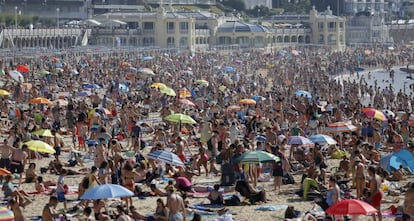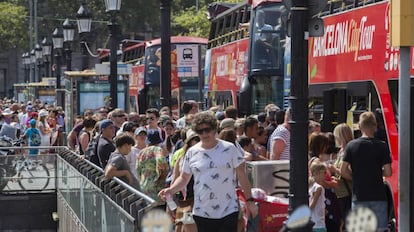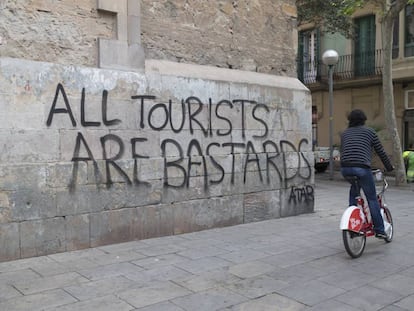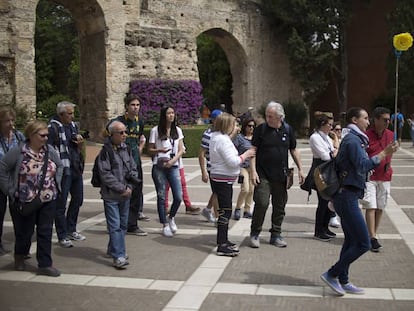As economy improves, Spaniards are taking vacations again
Tourism industry is expecting record figures in a year when both domestic and foreign travel are up
Experts are forecasting a rise in the number of Spaniards going on summer vacation this year. Following several years of decline due to the economic crisis, the tourism sector is optimistic that the trend will be reversed in 2017.

The Spanish Confederation of Hotels and Tourist Accommodation (CEHAT) does not keep separate figures on Spanish and foreign visitors, but it is confident that 2017 will be a record year for both.
This group notes that parts of Spain that traditionally receive very few foreign visitors – landlocked areas, the northern coastline and municipalities of 30,000 residents or fewer– have registered a visitor rise of over 40% from 2013, one of the worst years on record.
The CEHAT also says that small airports, typically used by national travelers, have been seeing greater activity.
The fact that Spaniards are traveling abroad more is a sign that the domestic economy is doing better
“There’s been a rise not just in the number of trips taken by Spaniards, but also their duration,” says Ramón Estalella, secretary general of CEHAT. “During the crisis, many domestic visitors only spent three nights out over the Easter vacation period. And this year there were many who stayed the entire week.”
Exceltur, the tourism industry’s lobby group, shares this optimism. “The economy’s strong performance and the containment of energy prices have encouraged spending by Spaniards during the spring, pushing up tourist spending,” reads the group’s second-quarter report.
The report underscores that all Spanish tourist consumption indicators have intensified their upward trend during the March-to-May period, helped along by the Easter break and good weather. The most relevant figures show a strong rise in non-hotel bookings: rural tourism grew 13.2%; licensed vacation rentals rose 11.8%; and campsite stays advanced 9.9%.

There was also a noticeable spike in spending on bookings for foreign trips (17.1%), as well as a 5.5% rise in luxury products such as four- and five-star hotel accommodations. Business trips also increased, according to figures released by the National Statistics Institute (INE).
José Antonio Pérez-Aranda, director of Barcelona University’s Tourism School CETT, also sees 2017 as the year of complete recovery. “Domestic tourism has grown in volume and in travel days,” he says. “Besides the economic recovery, there are other factors at play such as the emergence of the low-cost airline Level, which offers cheaper flights to Latin America and the US. We are seeing more short-term stays throughout the year, and an increase in trips abroad.”
In 2016, Spaniards undertook 182 million trips, a 3.7 % rise from 2015, on which they spent €41.4 billion, or 9.1% more.
Although Spaniards are mostly visiting European destinations, the biggest spikes were in the Asia-Pacific region
Although Spaniards are mostly visiting European destinations, the biggest spikes were in the Asia–Pacific region, where there was a 15.7% rise in Spanish tourist arrivals in 2016, according to ForwardKeys, a travel pattern analysis firm. There was also a 4.4% rise in trips to Canada and the US, and a 4.6% increase in trips to Latin America.
The fact that Spaniards are traveling abroad more is a sign that the domestic economy is doing better, because average spending abroad is much higher: €96 per person compared with €44 in Spain.
Last year, 39.5% of respondents in the INE’s Living Conditions Survey said that they could not even afford one week of vacation a year. During the worst of the crisis, that figure reached 45%.
English version by Susana Urra and George Mills.
Tired of tourists
Despite optimistic forecasts of another record year for Spanish tourism in 2017, the sector's buoyant mood is marred by a growing number of protests against an industry responsible for 11% of national GDP. In recent months, residents of cities including Barcelona and Madrid have spoken out against the gentrification of downtown areas during Spain's tourism boom, arguing locals are being pushed out of their homes by rising rents spurred on by the growing presence of accommodation platforms such as Airbnb.
There are also concerns that areas popular with tourists could lose their character and become little more than theme parks. Recently, authorities in Palma de Mallorca in Spain’s Balearic Islands declared a moratorium on new tourist accommodation, saying the city needed to rethink its tourism strategy. In another sign of the times, residents of Spain’s La Rioja region also took the streets to complain about the fact that tourists on the Camino de Santiago pilgrim route were driving up prices in local bars and restaurants.
And the Basque city of San Sebastián last month announced a plan to deal with “out-of-control tourism,” including a tourism tax for outsiders staying overnight and a bigger crackdown on unlicensed apartments used for vacation rentals.
Tu suscripción se está usando en otro dispositivo
¿Quieres añadir otro usuario a tu suscripción?
Si continúas leyendo en este dispositivo, no se podrá leer en el otro.
FlechaTu suscripción se está usando en otro dispositivo y solo puedes acceder a EL PAÍS desde un dispositivo a la vez.
Si quieres compartir tu cuenta, cambia tu suscripción a la modalidad Premium, así podrás añadir otro usuario. Cada uno accederá con su propia cuenta de email, lo que os permitirá personalizar vuestra experiencia en EL PAÍS.
¿Tienes una suscripción de empresa? Accede aquí para contratar más cuentas.
En el caso de no saber quién está usando tu cuenta, te recomendamos cambiar tu contraseña aquí.
Si decides continuar compartiendo tu cuenta, este mensaje se mostrará en tu dispositivo y en el de la otra persona que está usando tu cuenta de forma indefinida, afectando a tu experiencia de lectura. Puedes consultar aquí los términos y condiciones de la suscripción digital.
More information
Archived In
Últimas noticias
The complicated life of Francesca Albanese: A rising figure in Italy but barred from every bank by Trump’s sanctions
Half of Scotland is in the hands of 420 property owners
Pinochet’s victims grapple with José Antonio Kast’s rise in Chile
Reinhard Genzel, Nobel laureate in physics: ‘One-minute videos will never give you the truth’
Most viewed
- Pablo Escobar’s hippos: A serious environmental problem, 40 years on
- Why we lost the habit of sleeping in two segments and how that changed our sense of time
- Charles Dubouloz, mountaineering star, retires at 36 with a farewell tour inspired by Walter Bonatti
- Reinhard Genzel, Nobel laureate in physics: ‘One-minute videos will never give you the truth’
- The Florida Keys tourist paradise is besieged by immigration agents: ‘We’ve never seen anything like this’











































